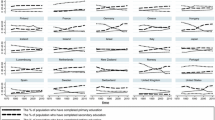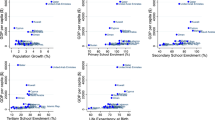Abstract
The objective of this paper is to analyze the effect of various compositions of human capital on economic growth. We construct alternative measures of human capital composition using five fields of study. In each instance, the measure represents the number of graduates in the respective field as a percentage of all graduates. The measures are as follows: agriculture human capital (AGR); high-tech human capital (TECH); business and service human capital (SERVICE); the humanities human capital (HUMAN); and health and welfare human capital (HEALTH). This paper uses the OLS and System-Generalized Method of Moments (GMM) models to explain differential rates of growth among developed and developing countries. The evidence indicates the significant effects of education and high-tech human capital on growth.

Similar content being viewed by others
Notes
We do not estimate the effect of primary education on economic growth here, since the average gross enrolment rate is 103.85% for our samples between year 1999 to 2006. That is, primary educations are almost fully established.
References
Arellano, M., & Bover, O. (1991). Some tests of specification for panel data: Monte Carlo evidence and an application to employment equations. Review of Economic Studies, 58, 277–297.
Arellano, M., & Bover, O. (1995). Another look at the instrumental variables estimation of error components models. Journal of Econometrics, 68, 29–51.
Barro, R. (1991). Economic growth in a cross section of countries. The Quarterly Journal of Economics, 106(2), 407–443.
Bertocchi, G., & Spagat, M. (1998). The evolution of modern educational systems: Technical versus general education, distributional conflict and growth. CEPR discussion paper, 1925.
Blundell, R., & Bond, S. (1998). Initial conditions and moment restrictions in dynamic panel data models. Journal of Econometrics, 87, 11–143.
Chatterji, M. (1998). Tertiary education and economic growth. Regional Studies, 32, 349–354.
Chen, S. & Luoh, M. (2009). Are mathematics and science test scores good indicators of labor-force quality? (in press).
Colombo, M. G., & Grilli, L. (2005). Founders’ human capital and the growth of new technology-based firms: A competence-based view. Research Policy, 34, 795–816.
Hanushek, E. A., & Kimko, D. D. (2000). Schooling, labor-force quality, and the growth of nations. American Economic Review, 90(5), 1184–1208.
Keller, K. R. (2006). Investment in primary, secondary, and higher education and the effects on economic growth. Contemporary Economic Policy, 34(1), 18–34.
Krueger, A. B., & Lindahl, M. (2001). Education for growth: Why and for whom? Journal of Economic Literature, American Economic Association, 39(4), 1101–1136.
Kwabena, G., Oliver, P., & Workie, M. (2006). Higher education and economic growth in Africa. The Journal of Development Studies, 42, 509–529.
Lee, K., & Kim, B. (2009). Both institutions and policies matter but differently for different income groups of countries: Determinants of long-run economic growth revisited. World Development, 37(3), 533–549.
Lindley, W. (1999) Quality improvement in undergraduate education. In Proceedings of the Inaugural Conference of the Global Consortium of Higher Education and Research for Agriculture, Amsterdam, The Netherlands.
Loening, J. (2005) Effects of primary, secondary, and tertitary educaiton on economic growth: Evidence from guatemala. Policy Research Working Ppaer NO. 3610, World Bank.
Mankiw, N. G., Romer, D., & Weil, D. N. (1992). A contribution to the empirics of economic growth. The Quarterly Journal of Economics, 107(2), 407–437.
Murphy, K., Shleifer, A., & Vishny, R. (1991). The allocation of talent: Implications for growth. Quarterly Journal Economics, CVI(2), 503–530.
Petrakis, P. E., & Stamakis, D. (2002). Growth and education levels: A comparative analysis. Economics of Education Review, 21, 513–521.
Richard, H. M. (2006). Can higher education foster economic growth? Chicago Fed Letter, Number 229.
Stephan, K. (1997). Which level of schooling has the greatest economic impact on output? Applied Economics Letters, 4, 177–180.
Tiago, N. S. (2007). Human capital composition, growth and development: An R&D growth model versus data. Empirical Economics, 32, 41–65.
Acknowledgments
We are particularly gratefully to the anonymous referees and the editor (A. C. Michalos) whose insightful and constructive comments have substantially improved this paper.
Author information
Authors and Affiliations
Corresponding author
Rights and permissions
About this article
Cite this article
Tsai, CL., Hung, MC. & Harriott, K. Human Capital Composition and Economic Growth. Soc Indic Res 99, 41–59 (2010). https://doi.org/10.1007/s11205-009-9565-z
Accepted:
Published:
Issue Date:
DOI: https://doi.org/10.1007/s11205-009-9565-z




